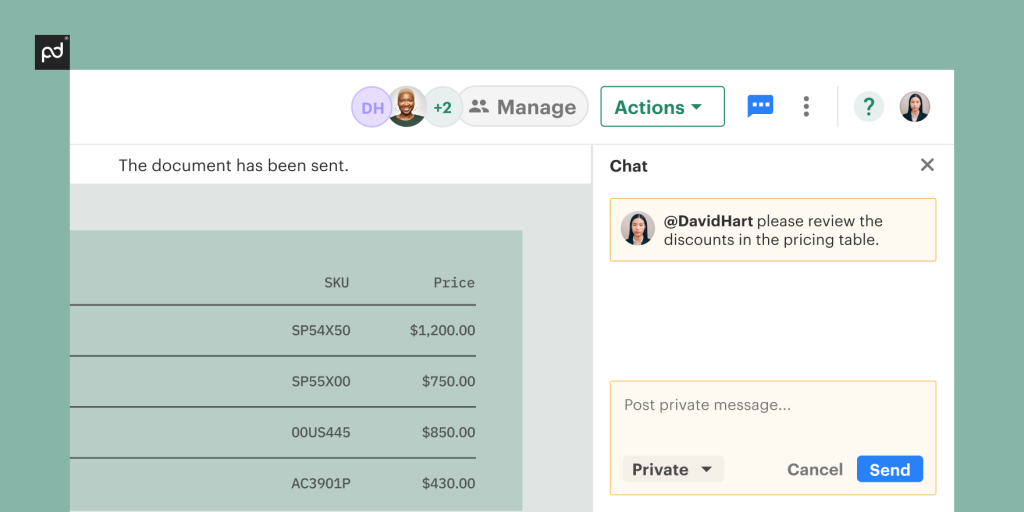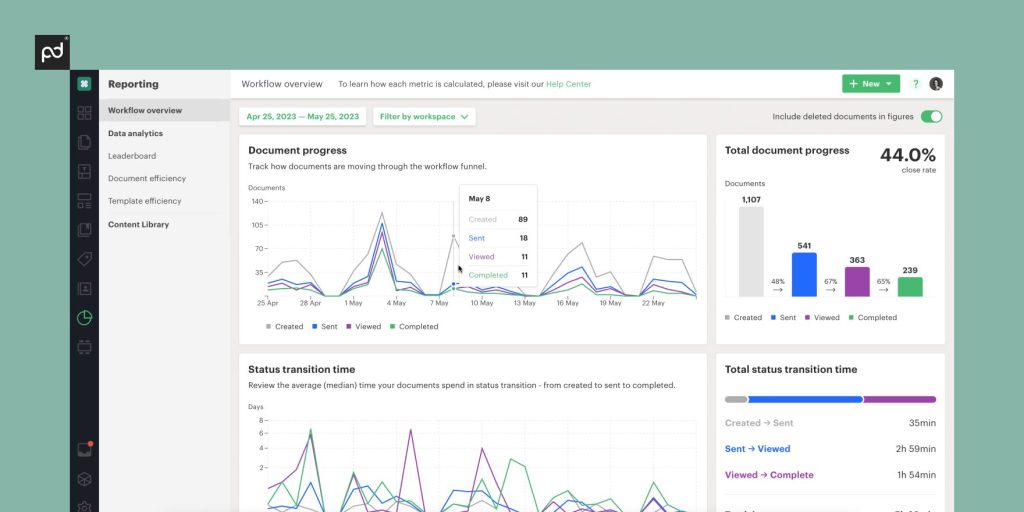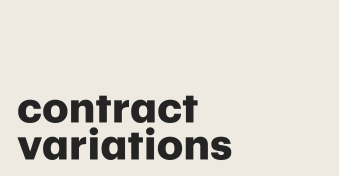Whether it’s a paper document or an e-signed electronic agreement, contracts establish the rights and obligations of the parties involved to ensure clarity and prevent potential disputes.
In this article, we look at what contract authoring is, its challenges, and the potential role of software in streamlining the process.
Key takeaways:
- Contract authoring is the process of drafting and creating contracts.
- Minimize the chance of disputes and protect the interests of all parties by authoring your contracts.
- Ensure all parties are clearly identified and that your document is concise.
- Contract management software allows for the easy management of the entire contract lifecycle.
What exactly is contract authoring?
Contracts are an essential aspect of business transactions and legal agreements.
Most companies deal with them regularly, so any deals must be executed correctly.
But what exactly is ‘contract authoring’? Well, this is the process of drafting and creating contracts.
It involves the careful composition of terms, conditions, and clauses to govern the legal agreement between the parties.
Contract authoring ensures that the contract accurately represents the intentions of the parties involved and protects their interests.
It’s one of the first stages in contract lifecycle management and is a great chance to put into writing any verbal terms that have already been discussed.
Why is contract authoring important?
Creating contracts can be complex and time-consuming, requiring attention to detail and legal expertise to execute correctly.
This is where contract authoring comes in.
Contract authoring involves the creation and drafting of legally binding agreements and is a vital part of contract management for several reasons.
What is contract management, you ask?
Essentially, it’s the process of effectively planning, administering and managing commercial contracts. Here’s how contract authoring can help.
It establishes an understanding
Contract authoring helps establish a clear and unambiguous understanding between parties.
Outlining rights, obligations, and expectations minimizes the chance of disputes and provides a legally binding framework that protects the interests of all parties.
Acts as a reference
Contract authoring also acts as a reference point in case of disagreements or conflicts.
If a dispute does occur, each party can refer to the contract to resolve any issues and determine an appropriate course of action.
This saves time and resources and ensures any resolution aligns with the original intentions of the parties.
Provides security
Contract authoring provides a sense of security and confidence for the businesses involved.
By making agreements formal and documenting them in writing, it establishes a legally enforceable agreement that holds both parties accountable.
It’s possible to transfer data between documents for contract authoring to make this process easier.
This helps to formalize the agreement, create a greater degree of certainty, and reduce the risks associated with verbal agreements and loosely defined arrangements.
Mitigates risks
What’s more, contract authoring can help mitigate risks.
By identifying and addressing potential risks upfront, such as liability, indemnification, and intellectual property rights, these contracts provide a framework for managing and allocating risk between the parties.
Supports better communication
Contract authoring also paves the way for more effective communication and negotiation.
During the drafting process, both parties have the opportunity to discuss and negotiate terms, ensuring the agreement aligns with their respective needs and expectations.
This open dialogue promotes a collaborative and mutually beneficial relationship between the parties.
Who should author a contract?
Authoring a contract should only be undertaken by legal professionals, such as lawyers or contract specialists with the necessary know-how and expertise in contract law.
These professionals should be well-versed in legal terminology, drafting techniques, and the specific requirements of different types of contracts.
Their involvement ensures that the contract accurately reflects the parties’ intentions, complies with applicable laws, and protects the interests of all involved.
Characteristics of a contract
Let’s take a look at the key characteristics of a contract:
1. The participants
A contract must clearly identify the parties involved in the agreement.
This includes their legal names, addresses, and any relevant identification or registration numbers. This is to make sure the contract is enforceable and legally binding.
2. Clear and concise
A contract should contain a clear and concise statement of purpose and the objectives of the agreement, outlining the nature of the transaction and setting the context for the subsequent terms and conditions.
3. Terms and conditions
The contract must include the terms and conditions of the agreement too. These should specify the rights, obligations, and responsibilities of each party.
They can also include any relevant timelines, milestones, or deliverables and should cover potential contingencies and mechanisms for dispute resolution.
4. Outline value exchanged
A contract should clearly outline the consideration or value exchanged between the parties.
This includes any monetary payments, goods, services, or other valuable considerations involved in the agreement.
5. Signatures
A contract requires the signatures of the parties involved, indicating their acceptance and an agreement to be bound by its terms and conditions.
Signatures serve as evidence of the parties’ intent and are essential for enforceability.
They can be signed in person or electronically, and these days, e-signatures are just as valid as signing in ink.
What happens during the contract authoring process?
So, what exactly happens during the contract authoring process? Well, this usually involves several steps to ensure the creation of a comprehensive and legally sound document. These include:
Gathering information
The contract authoring process begins with gathering necessary information about the parties, their intentions, and the nature of the agreement.
This includes understanding their requirements, objectives, and potential risks associated with the contract.
Initial drafting
Based on this information, an initial draft of the contract is prepared.
This involves structuring the contract, including inserting appropriate headings, clauses, and sub-clauses and addressing all relevant aspects of the agreement.
Review and editing
The draft contract is reviewed and edited for clarity, accuracy, and legal compliance.
This stage may involve multiple iterations as legal professionals and the parties involved provide feedback and suggest revisions.
Negotiation and revision
Parties may enter into a negotiation phase to address any disagreements or modifications required.
It’s here that parties can start an open dialogue and resolve any conflicting interests.
Finalization
Once all parties agree on the terms and conditions, the final version of the contract is prepared.
This incorporates the agreed-upon changes and is made ready for execution.
Execution
The contract is signed by all the parties involved, indicating their acceptance and agreement to be bound by its terms.
Signatures may be physical or electronic, depending on the applicable laws and preferences of the parties.
Challenges of contract authoring
Contract authoring can pose various challenges that may need to be addressed. Common issues include:
Legal complexity
Contract law can be complex and subject to interpretation.
Ensuring a contract accurately reflects the parties’ intentions while complying with legal requirements can thus be challenging, which means you’ll likely need the help of trained legal professionals.
Ambiguity and vagueness
Poorly drafted contracts, which lack clarity or contain ambiguous terms, may lead to misunderstandings and disputes.
It’s, therefore, vital that you carefully define and articulate the terms and conditions to avoid potential issues.
Time and resource constraints
Contract authoring can be time-consuming, especially when dealing with complex agreements or multiple parties.
Allocating enough hours and resources to the process is essential to ensure thoroughness and accuracy.
A changing legal landscape
Contract law and regulations can evolve over time, meaning contracts have to be periodically reviewed and updated to remain compliant.
Staying informed about legal developments is essential to avoid potential pitfalls.
How contract authoring software can help your business
As discussed, contract authoring is valuable to many businesses.
Luckily, contract management software can help with this process and offers a great solution to streamline and enhance it.
This software can provide a range of features and functionalities to simplify drafting, collaboration, and management of your contracts.
Here are some ways a contract authoring tool can benefit your business.
Templates and standardization
Intelligent contract authoring software often includes pre-built templates that you can customize according to your needs.
These serve as a great starting point, ensuring consistency and reducing the time spent on repetitive drafting tasks.
Moreover, you can save time and effort if your chosen provider has the ability to save reusable content such as contract clauses.

Collaboration and workflow management
Software facilitates collaboration among any stakeholders involved in the contract creation process.
It allows for real-time editing, commenting, and tracking of changes, enabling seamless communication and efficient workflow management.

Compliance and risk mitigation
Contract authoring software can integrate compliance features, such as clause libraries, to ensure adherence to legal regulations and internal policies.
It can also assist in identifying and addressing potential risks, such as non-compliant clauses or missing terms.
Version control and audit trails
Maintaining an accurate version history and audit trail becomes an effortless process too.
Contract authoring software enables easy tracking of changes, revisions, and approvals, ensuring transparency and accountability throughout the contract lifecycle.
Automation and efficiency
Contract authoring software can also automate repetitive tasks, such as populating contract fields, generating clauses, and managing deadlines.
This saves time, reduces human error, and increases overall efficiency within your team.
Integration and analytics
Many contract authoring software solutions offer integration capabilities with other systems, such as customer relationship management or enterprise resource planning software.
This allows for seamless data transfer and analysis, providing valuable insights into contract performance and compliance.

Easily manage contract lifecycles with PandaDoc
Contract authoring is a critical process for creating legally binding agreements.
It ensures clarity, establishes rights and obligations, and minimizes risks for the parties involved.
Using software, such as PandaDoc, can make it much easier, allowing you to create contracts, manage, and sign them all in one place.
By utilizing contract authoring software, businesses can streamline their contract creation process, enhance efficiency, and reduce the risks associated with contract management.
This helps avoid issues such as legal complexity and ambiguity.
PandaDoc offers several features that can assist with your contract lifecycle management, including:
- Integration with your CRM
- Templates to help you create contracts in minutes
- Collaboration between parties via easy document sharing
- Storing and managing documents in one place
Contract authoring software provides solutions to help overcome any and all challenges involved in this process, offering templates, collaboration tools, compliance features, automation, and even integration capabilities.
Why not get started with PandaDoc today?
Disclaimer
PandaDoc is not a law firm, or a substitute for an attorney or law firm. This page is not intended to and does not provide legal advice. Should you have legal questions on the validity of e-signatures or digital signatures and the enforceability thereof, please consult with an attorney or law firm. Use of PandaDocs services are governed by our Terms of Use and Privacy Policy.


